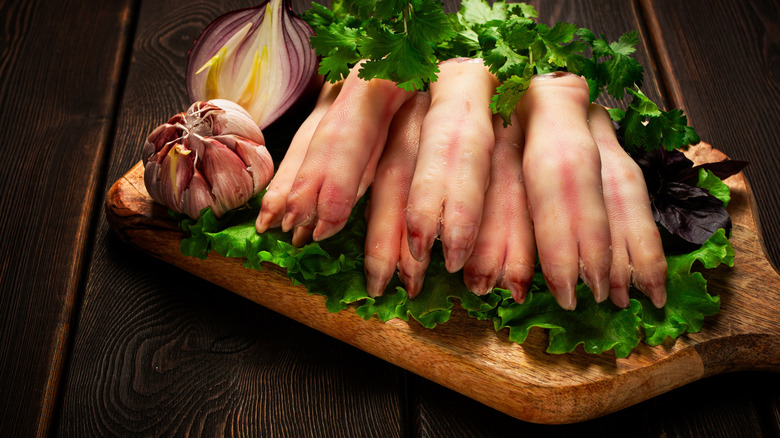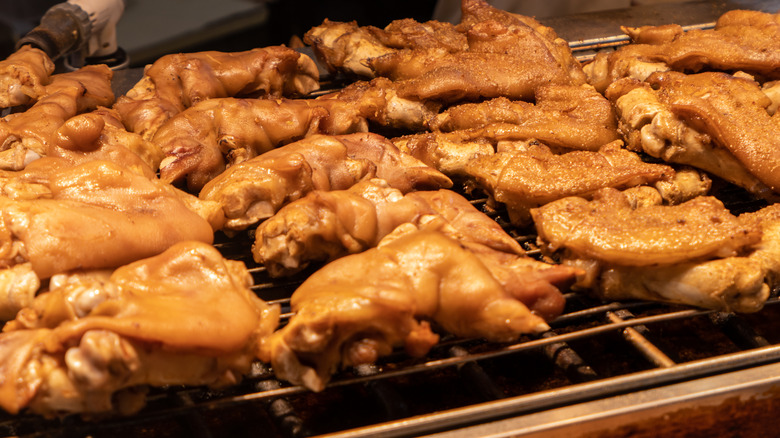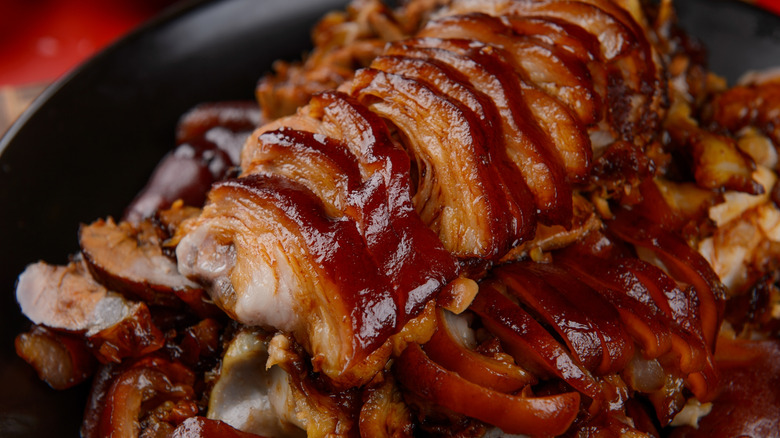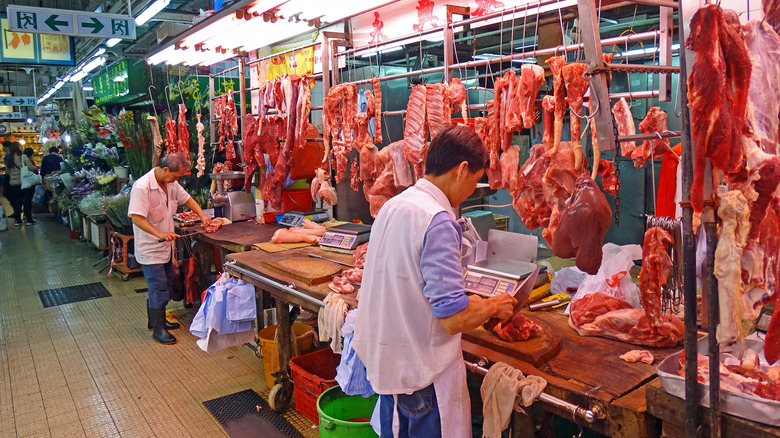Pig's Feet Is The Underrated Cut Of Pork You Should Know How To Cook
It's no secret many Americans these days avoid using a lot of animal parts considered delicacies in other countries. Sometimes it's because certain meats are straight-up illegal in the U.S., like lung meat. Most of the time, it's more to do with visual appeal. From offal to chicken feet, a lot of meat never lands on today's dining tables. It's certainly a deterrent for several parts of the otherwise popular pig. Pork snout looks and tastes like a big spongy nose while pig's ears are often fed to dogs. Pig's feet are popular in the American South and in Asian cuisines (Wanluan, Taiwan is known for its pig's feet dishes), but woefully underrated and under-appreciated by much of the rest of the country.
Unlike, say, a pork chop, pig's feet (also known as trotters or pettitoes, among other names) aren't abstracted through butchering. What you see is what you get: the toes and lower portion of a pig's legs, complete with pink skin. The feet are filled with small bones (knuckles), a lot of cartilage, and plenty of fat beneath the collagen-rich skin. They have a distinctive smokey, intense pork flavor that some describe as an acquired taste. But properly cooked, the bit of actual meat hiding inside is delectable and juicy. They're also affordable. So, if you're concerned at just how much grocery store prices have risen in the past few years, it might be time to buy a bunch of pig's feet and throw them in a pot with onions and spices.
How to cook pig's feet
There are three primary challenges when preparing pig's feet. First, each one should be cut in half, long ways, for easiest access to the meat. Unless you're an expert at deboning the whole foot like legendary chef Pierre Kaufmann, it's best to ask the butcher to bisect them in-store. It can take even experienced chefs a good five minutes to fully debone a single foot.
They also need to be thoroughly cleaned, as they're feet after all. Some people soak them overnight in the fridge in cold water, then rinse well. Others will rinse them in vinegar or a water and vinegar mix (vinegar is a moderately successful anti-bacterial and anti-fungal agent). Vinegar also adds a mustardy tinge to the sweet-and-smoky unctuousness of well-cooked pig's feet that many people feel adds a traditional or nostalgic note.
Finally, cooking times are generally long. It could take anywhere from two to four hours to fully braise, boil, or bake to completion. Some recipes call for more than one cooking treatment. They may be braised for three hours before throwing them on the grill. The long cooking time helps reduce the amount of collagen and/or gelatin in the fully cooked foot, and draws the meat off of the bone. One way to speed up cook time is to toss them into an Instant Pot or another type of pressure cooker, where (with a couple cups of water) they should be fall-off-the-bone delicious in about an hour.
Pro tips for making the best pig's feet
There are several useful tricks when making pig's feet. If the trotters are coming straight from a farm or specialty store, you may want to shave any hairs off the skin. Take care if you decide to process the hooves yourself, as the many small bones makes knife work tricky. It's worth watching a few videos to get the deboning or splitting process down properly.
When boiling, be prepared to regularly skim the gelatinous scum that floats to the top. If you're braising trotters, make sure and check periodically and add moisture as needed. If it dries out, the combination of high heat, rendered collagen, and sugars from sauces can morph into a cement-like glue if the dish dries out, ruining your cooking vessel.
If you're comfortable boning and skinning pig's feet, you can stuff them with anything from vegetables to lobster or sausage for an indulgent, smoky-savory treat. Or remove the skins all together after cooking and cook them down into cracklings or chicharrones. And if you don't want your finished dish to look like feet, cook everything sufficiently to fall off the bone, and separate before serving. Alternatively, add pieces to a hot pot dish, or remove all bones and tendons, finely chop the meat and skin, make small patties, and bread and fry them. Trotters are often served in a sauce. The intense pork flavor stands up well to spicy hot sauces and seasonings, or sticky-sweet barbecue sauce.
Where to find pig's feet
Pig's feet aren't exactly rare or exotic. They show up on menus across the country, from high-end Parisian restaurants to no-frills Southern soul food spots. They're intrinsic to much of the globe's diets, save for the billions of people who don't eat pork at all. There are four feet to each pig, and the average meat eater will eat almost 30 pigs in their lifetime. So why don't we see them more? Well, one needs to know where to look.
Trotters occasionally show up in the meat section of grocery stores. You can ask at the butcher counter, and they may be able to take care of you. Alternatively, seek out a stand-alone butcher shop or an Asian specialty store and you'll almost certainly find them. At T&T Supermarkets in Canada and Washington state, you can pick up three pounds for about $10.
Pickled pig's feet used to be a standard snack at industrial dive bars and roadside taverns across the country, though they've become something of a rarity in 21st century bars. However, you can still buy jars of Hormel pickled pig's feet in many grocery stores in the American South or get fancy and order a 16-ounce jar of Hannah's ready-to-eat pickled pig's feet for about $17.



